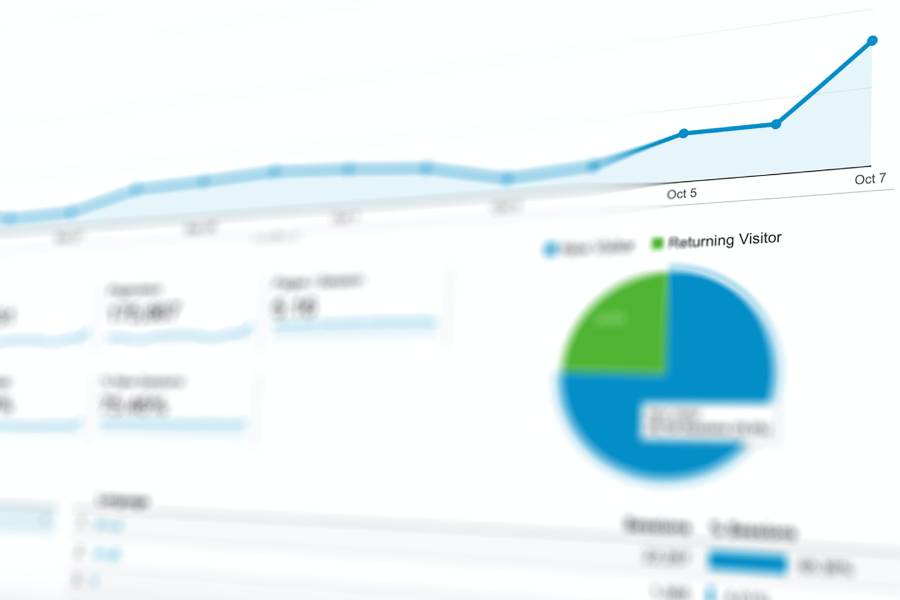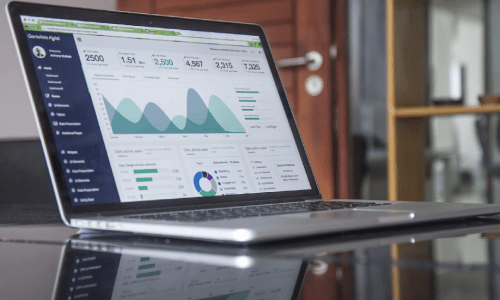The Essential Digital Marketing Metrics and KPIs to Track

Maximizing the effectiveness of your digital marketing campaigns requires more than just creating eye-catching ads or engaging social media posts. To truly understand how well your strategies are performing and make informed decisions for the future, you need to dive into the world of digital marketing metrics and key performance indicators (KPIs).
These numbers are like your campaign’s report card. They help you figure out what’s working and what’s not, whether you’re working on your website or using social media platforms like Facebook, LinkedIn, or YouTube.
However, not all digital marketing metrics are equally important. The key here is to focus on the ones that match your goals.
In this article, we help you determine the essential digital marketing metrics and KPIs to track, enabling you to learn more about your customers’ behavior and tailor your activities accordingly.
What Metrics Should a Digital Marketing Agency Report?
Delivering compelling, insightful, and impactful reports to clients as a digital marketing agency in the Philippines is a cornerstone of building trust, strengthening long-term client relationships, and showcasing the value of your services.
Here are some examples of key digital marketing metrics that your agency should include in its digital marketing reports:
• Goals
At the outset of any campaign, it’s crucial to establish clear and measurable goals. These goals provide a roadmap for your efforts and serve as a benchmark for success. Whether it’s increasing website traffic, generating leads, or boosting sales, explicitly stating these objectives sets the foundation for the entire campaign.
For example, if the goal for a local luxury property developer is to enhance brand visibility through real estate digital marketing efforts such as Facebook Ads, the report should outline how many new followers were gained on social media platforms and the growth in brand mentions.
• KPIs
Key Performance Indicators (KPIs) are the lifeblood of your digital marketing reports. It delivers essential insights to optimize marketing strategies, ensuring they remain adaptive, effective, and aligned with business goals. Without KPIs, it’s akin to navigating in the dark, as businesses would lack the essential metrics necessary to gauge progress and make informed adjustments.
Take, for example, how a lead generation campaign can have KPIs that might include the number of form submissions, conversion rates, and cost per lead. Based on certain KPIs, one can tell what the overarching goal of any campaign is, such as reducing spend without compromising overall cost-effectiveness.
Tailor your KPIs to align with your goals and consistently track them to gauge campaign progress accurately. This basically allows you to determine if your efforts are getting you closer to your goals.
• Well-structured data
Presenting data in an organized, visually appealing manner is crucial for conveying complex information effectively, particularly for an SEO agency, because it enables clients to grasp the tangible impact of their investment in search engine optimization.
For clients who may not be familiar with the technical intricacies of SEO, well-structured data visualization bridges the knowledge gap and allows them to readily comprehend the improvements in their website’s visibility, traffic, and search engine rankings.
Visual aids such as graphs, charts, and tables offer clients a rapid snapshot of trends and changes over time. Data can be separated into relevant categories to make comprehension easier. For instance, a line graph can illustrate the rise in website traffic throughout the campaign, segmented by traffic source.
• Insights and Recommendations
Data alone doesn’t tell the full story; insights and recommendations bridge the gap between numbers and actionable strategies. Analyze the data to explain why certain trends occurred and what actions should be taken to capitalize on successes and address shortcomings.
Let’s say your email open rates for a newsletter marketing campaign have declined, and the report – which is representative of their data – can also include a narrative that suggests how A/B testing for subject lines to improve engagement is a recommendation to implement.
• Progress Updates
Regularly updating clients on progress is essential to maintain their engagement, foster transparency, and enthusiasm throughout the campaign. Compare current data with historical data to demonstrate the changes, whether it’s growth or dips, and highlight significant milestones achieved during the reporting period.
If a paid advertising campaign, for example, exceeds the target click-through rate, emphasize this achievement and its potential impact on conversions.
But First, What Do We Exactly Mean by “Digital Marketing Metrics”?

In the data-driven landscape of digital marketing, success hinges on understanding the impact of your efforts, which can be represented by established digital marketing metrics.
We can define a digital marketing metric as a standard-of-sorts, one that serves to provide marketers with a trackable, measurable, and factual unit of progress, evidencing the results of their online initiatives. These digital marketing metrics analytics provide invaluable insights into the performance of various marketing strategies, enabling informed decision-making and the optimization of future campaigns.
From website traffic and social media engagement, to conversion rates and return on investment (ROI), digital marketing metrics form the foundation of a marketer’s analytical toolkit. What you do with the toolkit, however, can either help improve your campaign’s performance or set it off toward a misguided strategy.
The key lies in identifying the metrics that align with your campaign objectives. After all, you won’t get to build the rest of the house when you keep trying to screw in a Phillips head with a hammer.
Why Do Digital Marketing Metrics Matter for Agencies?
Digital marketing performance metrics play a crucial role in every SEO, PPC advertising, social media marketing, and email or content marketing campaign. It fundamentally allows the addressing of various pain points and challenges faced by agencies and the leveraging of hot leads or already-performing strategies.
These metrics provide valuable insights and data-driven information that enable digital marketing agencies to optimize their strategies, improve decision-making processes, and achieve their client’s business objectives. Without it, an agency would lack the ability to measure campaign performance, hindering informed decision-making and resource allocation. Moreover, without metrics, the agency would miss out on refining strategies over time and setting clear, achievable campaign objectives.
Let’s explore how different metrics serve to address different pain points:
- Connecting all data sources
Agencies often deal with “data fragmentation,” which is what happens when information is scattered across different platforms and channels. Metrics help by providing a unified view of data from various sources, allowing agencies to consolidate and analyze information effectively. This addresses the pain point of data silos, making it easier to understand the overall performance of marketing efforts and identify areas for improvement.
For example, a digital marketing agency uses a marketing analytics platform that integrates data from various sources like social media platforms, Google Analytics, and email marketing tools. This integrated approach allows the agency to see a holistic view of their client’s marketing performance, addressing the challenge of handling fragmented data.
Having a single source of data, which can serve as a single source of “truth” in dealing with campaign performance, enables you to ultimately make more informed and strategic decisions.
- Insights into audience behaviors
Understanding audience behavior is crucial for crafting effective marketing strategies, as it allows you to tailor your messaging, content, and delivery channels to precisely resonate with your target audience.
Metrics such as website traffic, user engagement, and demographic data provide insights into how audiences interact with content, what resonates with them, and which channels are most effective. This helps agencies tailor campaigns to meet audience preferences, enhancing the customer experience, and increasing the likelihood of conversions.
- Tracking campaign performance
Metrics related to click-through rates, conversion rates, and engagement metrics enable agencies to monitor the performance of individual campaigns. These “headliner” metrics fundamentally provide an immediate look at how effective a campaign is at what it is trying to achieve.
Let’s say a software company launches a pay-per-click (PPC) campaign to promote its new product. By tracking metrics such as click-through rates and conversion rates, the conversion rate optimization agency managing the campaign can identify that one ad variation is performing exceptionally well. And in such cases, wherein one is aware of an upward trend in performance, allocating more budget to this high-performing ad can help optimize the campaign’s overall success.
By tracking metrics that help tell a campaign’s performance and turn it into a story, agencies can identify what works best for their brand or business, allowing them to make real-time adjustments to optimize campaign performance.
Ultimately, tracking campaign performance metrics addresses the challenges that stem from uncertainty over the delivery of desired results.
- Justify marketing expenses and define budgets
Marketing budgets are often scrutinized, and agencies need to demonstrate the value of their efforts. Metrics provide tangible evidence of the impact of marketing campaigns, making it easier to justify expenses and allocate budgets effectively.
When agencies can show the return on investment (ROI) through metrics like customer acquisition cost (CAC) and customer lifetime value (CLV), they can build stronger relationships with clients and stakeholders.
- For global marketing strategies
Metrics are particularly valuable when dealing with global marketing strategies. Different markets and cultures may respond differently to campaigns. Metrics help agencies gauge the effectiveness of their strategies in various regions, allowing them to tailor their approaches and messaging to suit local preferences. This ensures that global marketing efforts are relevant and resonate with diverse audiences.
For instance, an international tourism agency notices that their Facebook ads focusing on adventure travel receive higher engagement in European countries compared to Asian countries. This insight guides them to craft separate ad campaigns for different regions, tailoring the content to match each region’s preferences.
- Achieve business goals

Ultimately, businesses have specific goals, whether it’s increasing sales, building brand awareness, or driving website traffic, among many others, and the effectiveness of these goals can only be realized through the “universal truth” that data offers.
Metrics provide agencies with measurable data that directly relate to these goals. By aligning their strategies with the right metrics, agencies can demonstrate how their efforts contribute to achieving these business objectives, strengthening their role as strategic partners, and further cementing the significance of implementing a data-driven approach to digital marketing.
The Difference Between Digital Marketing Metrics vs KPIs
The terms “metrics” and “Key Performance Indicators (KPIs)” are often used interchangeably, but they carry distinct meanings and purposes in terms of performance measurement.
So, while synonymous, here’s how metrics and KPIs differ:
Metrics primarily quantify the execution or advancement of specific actions or tasks. They tend to be detailed and operational, offering insights into the effectiveness of individual marketing strategies. For instance, if the aim is to assess the contribution of a landing page to the objective of increasing sales, the metric to focus on might be the conversion rate.
What is a KPI in digital marketing?
Key performance indicators, or KPIs, are closely tied to the overarching business objectives of a company and represent critical targets that reflect a level of success in achieving those objectives. In digital marketing, KPIs offer a more comprehensive view of the overall health and success of a campaign. These are carefully selected based on their alignment with key business goals, offering a top-level perspective on performance, and an immediate idea of a campaign’s well being.
For example, if your goal is to boost sales by 30% over the next quarter, multiple KPIs could be established to offer a complete understanding of the team’s progress (e.g., acquisition of new customers, conversion rate, and churn rate).
A KPI can essentially encompass several metrics, yet not all metrics qualify as KPIs.
If your goal is to boost sales, simply tracking website visitors isn’t a KPI, it’s a metric. Because website traffic alone isn’t tied to your goal of increasing sales figures. But if you understand how traffic translates to form submissions, it can become an important metric to track.
Different businesses may have varying goals, ranging from increasing website traffic to boosting online sales or enhancing customer engagement – to name the most common. To ensure that they are tracking the appropriate metrics and KPIs, clients need to first define their objectives clearly.
Why so? Shouldn’t the agency know how to define a client’s objectives for their digital marketing campaign?
A well-defined objective will serve as a compass, guiding the selection of KPIs that align with the desired outcomes. Every business or brand is unique in one way or another – which means that every brand will also have unique problems that will require unique solutions. An agency will know what steps to take or at least have an idea of how to move forward, but only the client can definitively determine what their overarching goal is, after all.
Once objectives are set, businesses can then identify relevant metrics that provide insights into the performance of the chosen strategies. For instance, if the goal is to increase online sales, metrics like conversion rates, average order value, and shopping cart abandonment rates become crucial indicators. Additionally, businesses should consider the entire customer journey and select metrics that cover different stages, from awareness to conversion and retention.
Types of Digital Marketing Report Metrics
When it comes to evaluating the effectiveness of your digital marketing strategies, understanding various types of metrics is essential. These metrics shed light on different aspects of your campaigns, helping you make informed decisions and optimize your marketing efforts.
Let’s explore three key categories of digital marketing report metrics: Awareness, Engagement, and Performance.
- Awareness
Awareness metrics offer insights into the initial interactions between your business and potential customers. These metrics are concerned with the visibility of your brand and its products or services. They help you understand how effectively your marketing efforts are introducing your business to a wider audience.
By definition, awareness metrics track what happens when your business comes in contact with a lead for the first time, typically through a paid ad, a field event, or organic search engine results.
Here’s an analogy: Imagine you’re a new coffee shop owner aiming to attract local customers. You put up eye-catching posters around town to let people know about your grand opening.
The number of times these posters are seen is referred to as an “impression.” Out of those impressions, the actual number of individuals who notice the posters constitutes the “reach.” If a percentage of those who saw the posters visit your website, then that’s the “click-through rate” or CTR.
Additionally, if people start mentioning your coffee shop on social media, those are referred to as “social media mentions.” When folks find your website through search engines without clicking on ads, it’s “organic search traffic.”
By asking people if they’re aware of your coffee shop, you can conduct a “brand awareness survey.” All these metrics collectively provide insights into how effectively your coffee shop’s name and offerings are noticed in the community.
- Engagement
Once potential customers have been introduced to or have grown aware of your brand, engagement metrics can help you gauge their level of interest and interaction. These metrics demonstrate the effectiveness of your content in capturing and retaining your audience’s attention, which then compels them to perform an action.
Engagement metrics, at its core, measure how often and how quickly top-funnel leads are converted into qualified leads and ultimately into sales.
Consider you run an online DIY crafts blog, and you share creative project ideas on social media. When your followers like, share, and comment on your craft posts, that’s “engagement.” When people watch your crafting tutorial videos, those are “video views.” Similarly, if your social media followers interact with your posts by liking, sharing, or commenting, that’s “social media engagement.” These metrics help you understand how captivating your content is and how well it resonates with your audience.
- Performance
Picture an online store having a huge sneaker sale. Out of all the potential customers or online store visitors, a few decide to buy – that’s the “conversion rate.” If the sale generates more revenue than the cost, that’s the “return on investment (ROI).” Additionally, if customers who bought during the sale continue shopping and contribute to your business over time, that’s their “customer lifetime value (CLV).” The total revenue generated from the sale is “sales revenue.”
If the performance of the online store’s promo shows that the conversion rate is higher than the last time the brand had a sale, then it can validate how the metric is indicative of success.
The success of your marketing efforts boils down to performance metrics, which provide a clear picture of how your campaigns impact your bottom line. These metrics tie your marketing efforts directly to revenue and profitability.
Track and Measure the Right Metrics for Your Digital Marketing Campaign
Knowing what metrics to track and measure can help you form a general picture of your typical audience. You learn about what kind of campaign is working and conversely, you also find out what parts of your campaign are less engaging. That allows you to improve your performance and help you review how you have positioned your offering.
Here’s a list of digital marketing metrics to track per each digital marketing service:
I. Website Traffic Metric
• Top Pages
Top Pages refers to the web pages on your website that receive the highest amount of traffic or visits within a specific time frame. This metric helps you identify which pages are most popular among your audience. It provides insights into the type of content that resonates well and helps you optimize and focus your efforts on those pages to drive further engagement or conversions.
To measure Top Pages, you can use website analytics tools like Google Analytics. These tools track the number of visits each page receives and rank them based on traffic volume. You can compute this by analyzing the page-level traffic data and sorting it from highest to lowest.
• New Visitors
“New Visitors,” as its label suggests, are individuals who visit your website for the first time within a specific period. Monitoring new visitors helps gauge the effectiveness of your marketing efforts in attracting new potential customers. It’s essential for expanding your audience and increasing your brand’s reach.
To compute the number of new visitors, the website analytics tool checks if the visitor’s session history includes any previous visits. If not, the visitor is classified as new.
• Bounce Rate
Bounce rate measures the amount of time spent on your site before a visitor leaves without taking any action. A high bounce rate could indicate that visitors are not finding what they’re looking for or that the page’s content isn’t engaging enough. It’s crucial to lower the bounce rate as it signifies the effectiveness of your landing pages.
Bounce Rate is calculated by dividing the number of single-page visits (where the visitor bounces) by the total number of visits to that page.
• Returning Visitors
Returning Visitors are individuals who have visited your website before and are coming back for another session within a specific timeframe. A high number of returning visitors suggests that your website has valuable content and a loyal audience. It can also indicate the success of your efforts in building a brand that people want to engage with repeatedly.
It can be tracked by website analytics tools that recognize repeat visits from the same device or user account. The tool differentiates these visits from new ones and provides you with the count.
Website traffic metrics provide a comprehensive snapshot of a website’s performance by tracking key data points such as the number of visitors, unique users, bounce rate, and average session duration. These metrics are vital for understanding the effectiveness of an online presence and campaign strategies, enabling clients to gauge the impact of their digital efforts on audience engagement, and user behavior.
II. SEO Content Performance Report Metrics
• Keyword Performance

Keyword Performance refers to how well specific keywords or search terms are working accordingly in terms of driving traffic and engagement to your website.
Monitoring keyword performance helps you understand which keywords are effective in attracting visitors. It’s essential for optimizing your content strategy and focusing on the keywords that resonate with your target audience, boosting your SEO ROI.
You can measure keyword performance by tracking metrics like keyword rankings, search volume, click-through rate (CTR), and impressions. Tools like Google Search Console or third-party SEO platforms provide this data. You can compute metrics like CTR by dividing clicks by impressions and multiplying by 100.
• Organic and Paid Traffic
Organic traffic comes from search engine results where users find your website naturally, while paid traffic comes from paid advertising campaigns. Organic traffic indicates how well your website ranks in search engines, while paid traffic reflects the effectiveness of your online advertising campaigns. Comparing the two helps you balance your SEO and advertising strategies.
Organic traffic can be measured using tools like Google Analytics, which tracks visits from non-paid search results. Paid traffic is tracked through advertising platforms like Google Ads. The metrics are provided as the number of sessions for organic traffic and clicks for paid traffic.
• Conversions
Conversions refer to desired actions taken by users on your website, such as signing up, making a purchase, or downloading content.
Do you want your customer to contact you? Then you should be tracking signups. Or maybe you have got a white paper, offering in-depth industry research – in which case you’re tracking downloads.
Conversions are the ultimate goal of your website. Monitoring conversion rates helps you understand the effectiveness of your content, user experience, and calls to action in driving user engagement and achieving business objectives.
Conversion tracking is set up through tools like Google Analytics. You define what actions constitute a conversion (e.g., completing a form), and the tool records them. The conversion rate is calculated by dividing the number of conversions by the total number of visitors or sessions and then multiplying by 100.
• Backlinks
Backlinks are links from external websites that point to your website’s pages. They are a strong indicator of the authority and relevance of your content. High-quality backlinks can improve your website’s search engine visibility and domain authority.
Backlinks can be measured using tools like Ahrefs, Moz, or SEMrush. These tools provide information about the number of backlinks, referring domains, and the quality of the links. The metrics are usually presented as counts and quality scores.
• Top-Performing Pages
Top-performing pages are the web pages on your site that attract the most traffic, engagement, or conversions. Identifying top-performing pages helps you understand which content resonates with your audience and what formats are effective. This insight can guide your content creation and optimization efforts.
Top-performing pages are usually identified based on metrics like page views, time on page, bounce rate, and conversion rates. Website analytics tools provide this information, and you can compute it by sorting pages based on these metrics.
An SEO content performance report, for instance, will highlight the metrics that provide a comprehensive overview of the effectiveness and impact of an SEO campaign. This report encompasses key performance indicators such as organic search traffic, keyword rankings, and backlink growth.
By analyzing these metrics, clients gain valuable insights into their website’s visibility, user engagement, and conversion potential. This data-driven analysis enables clients to assess the success of their SEO efforts, make informed decisions for optimizing content strategies, and align their online presence with business goals.
III. PPC Campaign Performance Report Metrics
• ROAS (Return on Ad Spend)
ROAS is a metric that measures the revenue generated from your advertising campaigns relative to the amount spent on those campaigns. It’s usually expressed as a ratio or percentage.
It indicates how effectively your ad spend is translating into revenue. A higher ROAS suggests that your campaigns are generating more revenue per dollar spent, making it a crucial metric for assessing the profitability of your advertising efforts.
ROAS is calculated by dividing the revenue generated from the ads by the total ad spend. For example, if you earned $500 from an ad campaign that cost you $100, your ROAS would be $5 (500 / 100).
• CTR (Click-Through Rate)
CTR is the ratio of users who click on your ad compared to the total number of users who saw the ad. It’s typically presented as a percentage. It reflects the effectiveness of your ad’s content and relevance to the target audience. A higher CTR indicates that your ad is compelling and enticing enough to drive user engagement.
CTR is calculated by dividing the number of clicks on an ad by the number of impressions (multiplied by the number of instances that the ad was shown), then multiplying by 100 to get the percentage.
• ROI (Return on Investment)
ROI is a measure of the profitability of an investment, including advertising campaigns. It compares the net profit generated by the investment to the cost of the investment. It also helps you understand how much profit your advertising campaigns are generating relative to the investment you’ve made.
It is calculated by subtracting the cost of the investment from the revenue generated, and then dividing the result by the cost of the investment. This value is often expressed as a percentage.
The formula is:
((Revenue – Cost) / Cost) * 100.
• Cost Per Conversion
Cost Per Conversion (not to be confused with Cost Per Click or CPC), also known as Cost Per Action (CPA), measures the average cost incurred to achieve a specific desired action, such as a purchase or sign-up, through your ads.
It provides insight into the efficiency of your advertising spend in achieving your desired outcomes. Lowering your CPA indicates that you’re getting more conversions for each dollar spent.
It is calculated by dividing the total cost of the advertising campaign by the number of conversions generated. For example, if your campaign costs $500 and results in 20 conversions, your Cost Per Conversion would be $25 (500 / 20).
The metrics in a PPC campaign performance report often shows important numbers like how many people clicked on your ads, how much each click costs, how many turned into customers, and how much money you’re making from the ads.
By looking at these numbers, you can figure out if your ads are working effectively, and you can make smart choices to improve them, like choosing better keywords or adjusting your budget. This report helps you see if your ads are helping your business and guides you in making decisions to grow online and make more profit.
IV. Social Media Marketing Metrics
• Likes, comments, shares
“Likes” indicate users’ approval or interest in your content, “comments” reflect direct interactions and conversations, and “shares” show users passing on your content to their network. These engagement metrics gauge how well your content resonates with your audience. Higher engagement signifies strong content that could lead to increased visibility, broader reach, and enhanced brand awareness.
Social media platforms display the count for each engagement type on your posts. Add up the number of likes, comments, and shares to get the total engagement for each post.
• Follower growth rate
This quantifies the rate at which your social media followers are increasing over a specific period. A growing follower count indicates increasing interest in your brand and content. It highlights the effectiveness of your social media efforts in attracting and retaining an audience.
You can calculate the follower growth rate by subtracting the initial number of followers from the final number of followers and then dividing the result by the initial number of followers. Multiply by 100 to express the growth rate as a percentage.
• Impressions
As mentioned earlier, impressions represent the total number of times your content has been displayed on users’ screens. It provides insights into the potential reach of your content. While not a direct measure of engagement, higher impressions suggest that your content has been seen by a larger audience, which means that it is highly relevant on search.
Simply sum up the impressions for all your posts over a specific period to get the total impressions.
• Brand mentions, reviews, testimonials
These metrics involve users mentioning your brand in their posts, and providing reviews or testimonials about their experience with your products or services. Positive brand mentions, reviews, and testimonials build trust, credibility, and social proof for your brand. They influence potential customers’ perceptions and decisions.
Always monitor social media platforms, review sites, and relevant forums for mentions, reviews, and testimonials about your brand. Count the number of positive mentions and reviews to measure the impact.
• Conversions
This represents specific actions that users take in response to your social media content. These actions align with your business goals, such as making a purchase, signing up for a newsletter, downloading content, or visiting a particular webpage – it basically represents the number of instances a user “converts” according to a campaign’s objectives.
Conversions reflect the direct impact of your social media efforts on your business objectives. They provide insight into the effectiveness of your content and calls to action.
Use analytics tools and tracking codes to monitor user actions that lead to conversions. Calculate the number of completed actions (e.g., purchases, sign-ups) and divide by the total number of interactions or clicks related to that action. Multiply by 100 to get the conversion rate as a percentage.
By understanding these numbers, you can see which posts are resonating with your audience, what content is driving the most interaction, and how your social media presence is growing over time. This information is crucial for clients as it helps them gauge the effectiveness of their social media campaigns, refine their content strategies, and make informed decisions to connect better with their audience.
Ultimately, these metrics enable clients to measure the impact of their social media efforts, enhance their online brand presence, and foster meaningful connections with their target audience.
V. Email Marketing Metrics
• Open Rate
This refers to the percentage of recipients who open the emails you’ve sent. Open Rate indicates the effectiveness of your email subject lines and the level of interest your audience has in your content. A higher open rate suggests that your subject lines are engaging and compelling.
• Unsubscribe rate
The unsubscribe rate represents the percentage of recipients who choose to opt-out and unsubscribe from your email list after receiving an email. This helps you understand whether your content aligns with your subscribers’ expectations and preferences. A high unsubscribe rate could signal that your content isn’t resonating well.
Email marketing platforms provide the unsubscribe rate as a percentage. To calculate it: divide the number of unsubscribes by the number of emails delivered, then multiply by 100.
• Click-Through Rate (CTR)
CTR is the percentage of recipients who clicked on a link within your email. It measures the effectiveness of your email content and the relevance of your call to action. A higher CTR indicates that your content is driving engagement and compelling readers to take the next step.
To get the CTR, divide the number of clicks by the number of emails delivered, then multiply by 100.
• Conversion Rate
This represents the percentage of recipients who completed a desired action after clicking on a link within your email. This could be making a purchase, signing up, or downloading a file, etc.
Conversion Rate directly ties email marketing to your business goals, showing how well your emails drive desired actions. A higher conversion rate indicates that your email content and call-to-action are effective.
Calculate the conversion rate by dividing the number of conversions (desired actions) by the number of clicks generated from the email link. Multiply by 100 to express it as a percentage.
• Return On Investment (ROI)
ROI is a measure of the profitability of your email marketing campaigns, comparing the revenue generated to the cost of running the campaigns. It assesses the financial impact of your email marketing efforts. Positive ROI indicates that your campaigns are generating more revenue than you’re spending.
To calculate ROI, subtract the total cost of your email marketing campaigns from the total revenue generated, then divide the result by the total cost. Multiply by 100 to express it as a percentage.
Email marketing metrics will help you understand how engaged your audience is with your emails and whether your content is resonating. By analyzing these numbers, you can tailor your email content and strategies, sending more relevant messages to your subscribers. This information is vital for clients as it allows them to measure the impact of their email campaigns, refine their messaging, and build stronger connections with their audience
VI. General Marketing Campaign Metrics
• Customer Lifetime Value (CLV)
CLV is the predicted total value that a customer will bring to your business throughout their entire relationship with your brand. It helps you understand the long-term worth of a customer. This insight is crucial for making decisions about marketing budgets, customer retention efforts, and identifying high-value customer segments.
This can be measured by analyzing historical customer data. To compute it, subtract the total cost of acquiring and serving a customer from the total revenue generated (from that customer) over their relationship with your business.
• Customer Retention Rate (CRR)
Customer Retention Rate is the percentage of customers who continue to do business with you over a specific period. It reflects how well you’re retaining customers and keeping them engaged. Higher retention rates indicate customer satisfaction and loyalty, which can lead to more stable revenue streams.
Calculate CRR by taking the number of customers at the end of a period, subtracting the number of new customers acquired during that period, and then dividing by the number of customers at the beginning of the period. Multiply by 100 to get the retention rate percentage.
• Cost Per Acquisition (CPA)
Cost Per Acquisition is the average amount spent to gain a new customer through a marketing campaign. CPA helps you understand the efficiency of your marketing efforts in attracting and converting new customers. A lower CPA indicates cost-effective campaigns that yield valuable customers.
To measure CPA, divide the total cost of a marketing campaign by the number of new customers acquired as a result of that campaign.
• Cost Per Lead (CPL)
Cost Per Lead is the average expense incurred to generate a potential customer or lead through a marketing campaign.CPL evaluates the cost-effectiveness of your lead generation efforts. A lower CPL suggests efficient campaigns that drive potential customers at a reasonable cost.
To calculate, divide the total cost of a lead generation campaign by the number of leads generated as a result of that campaign.
By analyzing these general marketing campaign metrics, clients can gauge the effectiveness of their marketing efforts, understand audience behavior and preferences, optimize strategies based on data-driven insights, and allocate resources more efficiently.
In order to translate these metrics into actionable strategies and foster continuous improvement, the frequency of campaign reporting plays a pivotal role. Regular reporting allows clients to monitor trends, track progress over time, and swiftly adapt strategies based on real-time feedback.
Whether through weekly, monthly, or quarterly reporting, the cadence chosen should align with the campaign’s duration and the pace of changes in the industry landscape. This iterative approach not only shows transparency between marketers and clients but also ensures that campaigns remain dynamic and responsive to evolving market dynamics.
How Often Should Your Digital Marketing Agency Report?
Regular reporting allows you to track progress, identify trends, and ensure that your efforts align with your business goals. However, the frequency of reporting can vary widely based on factors such as campaign complexity, objectives, and the preferences of both your agency and your clients.You can adjust the reporting frequency to match your needs, whether it’s daily, weekly, bimonthly, monthly, quarterly, or annually.
1. Daily Reporting
Daily reporting is best suited for time-sensitive campaigns, such as short-term promotions or events. If your digital marketing agency is running a campaign that requires real-time adjustments, like a social media event coverage or a flash sale, daily reporting can help you quickly identify trends, make on-the-fly changes, and ensure that your strategy remains effective throughout the campaign’s duration.
2. Weekly Reporting
Weekly reports provide a good balance between staying updated and avoiding information overload. This frequency is particularly useful for campaigns with ongoing tactics that might need fine-tuning. It allows you to catch emerging trends and identify early signs of underperformance, making it easier to adjust strategies before issues become more significant.
3. Bimonthly Reporting
Bimonthly reporting strikes a balance between weekly and monthly reporting. It’s useful for campaigns that involve multiple channels or strategies and require a bit more time for comprehensive data collection and analysis. This reporting cadence allows for deeper insights without the overwhelm of more frequent reports.
4. Monthly Reporting
Monthly reports are a standard choice for many digital marketing agencies. They provide a holistic view of your campaigns’ performance over a longer period, allowing you to analyze trends and assess the overall effectiveness of your strategies. Monthly reports are often well-suited for clients who prefer a higher-level overview without being inundated with data.
According to a study conducted by the Content Marketing Institute, nearly 46% of marketers opt for monthly reporting, finding it to be the ideal balance between timely updates and comprehensive analysis. By aggregating data over a month, these reports reveal patterns that might not be as evident in shorter intervals, enabling clients to make informed decisions that are grounded in a deeper understanding of their campaigns’ performance.
5. Quarterly Reporting
Quarterly reports are particularly beneficial for long-term campaigns, where changes may not be immediately noticeable month-to-month. This reporting frequency enables you to track progress over a broader timeframe and evaluate the success of more significant changes or initiatives. It’s also a great opportunity to assess campaign alignment with your clients’ overarching business goals.
6. Annual Reporting
Annual reports are suitable for reviewing the overall performance of your digital marketing efforts in a larger context. This is especially relevant for measuring year-over-year growth, conducting in-depth analyses, and setting strategic goals for the upcoming year.
Annual reporting is ideal for demonstrating the long-term value of your agency’s services and fostering a deeper understanding of the impact of your strategies.
Choosing the Right Reporting Frequency
The appropriate reporting frequency for your digital marketing agency depends on several factors:
Campaign Objectives
Short-term campaigns might benefit from daily or weekly reporting, while long-term strategies align better with monthly, quarterly, or annual reporting.
Client Preferences
Consider your clients’ preferences for receiving and digesting information. Some clients may prefer more frequent updates, while others may value a more comprehensive, less frequent overview.
Resource Allocation
Keep in mind the resources required to generate reports at different intervals. More frequent reporting demands more resources for data collection, analysis, and presentation.
Campaign Complexity
Complex campaigns with multiple moving parts might warrant less frequent reporting to ensure that data is thoroughly analyzed and insights are actionable.
Measure What Matters in Your Digital Marketing Campaigns
Here’s a simple truth: If you don’t measure it, you can’t make it better. As a business owner, you’re well aware of the crucial role that data-driven insights play in steering your brand toward success.
It’s not just about understanding various digital marketing metrics and key performance indicators (KPIs); it’s about seamlessly integrating these valuable insights with the latest trends and effective techniques that define digital marketing today.
If you’re looking for a digital marketing agency in the Philippines that knows how to leverage data, send us a message, and let’s start measuring, tracking, and optimizing the right metrics to grow your brand.









